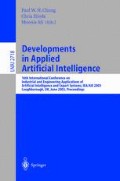Abstract
To augment communication channels of human-computer interaction, various kinds of sound recognition are required. In particular, musical instrument indentification is one of the primitive functions in obtaining auditory information. The pitch dependency of timbres has not been fully exploited in musical instrument identification. In this paper, we present a method using an F0-dependent multivariate. normal distribution of which mean is represented by a cubic polynomial of fundamental frequency (F0). This F0-dependent mean function represents the pitch dependency of each feature, while the F0-normalized covariance represents its non-pitch dependency. Musical instrument sounds are first analyzed by the F0-dependent multivariate normal distribution, and then identified by using the discriminant function based on the Bayes decision rule. Experimental results of identifying 6,247 solo tones of 19 musical instruments by 10-fold cross validation showed that the proposed method improved the recognition rate at individual-instrument level from 75.73% to 79.73%, and the recognition rate at category level from 88.20% to 90.65%. Based on these results, systematic generation of musical sound ontology is investigated by using the C5.0 decision tree program.
This research was partially supported by the Ministry of Education, Culture, Sports, Science and Technology, Grant-in-Aid for Scientific Research (B), No.12480090, and Informatics Research Center for Development of Knowledge Society Infrastructure (COE program of MEXT, Japan)
Access this chapter
Tax calculation will be finalised at checkout
Purchases are for personal use only
Preview
Unable to display preview. Download preview PDF.
References
Amatriain, X., and Herrera, P. Audio content transmission. In Proceedings of the COST G-6. Conference on Digital Audio Effects (DAFx01) (Dec. 2001), pp. 71–76.
Brown, J. C. Computer identification of musical instruments using pattern recognition with cepstral coefficients as features. Journal of Acoustic Society of America 103,3 (1999), 1933–1941.
Eronen, A., and Klapuri, A. Musical instrument recognition using cepstral coefficients and temporal features. In Proceedings of 2000 International Conference on Acoustics, Speech. and Signal Processing (ICASSP-2000) (2000), IEEE, pp. 753–756.
Fujinaga, I., and MacMillan, K. Realtime recognition of orchestral instruments. In Proceedings. of International Computer Music Conference (ICMC) (2000).
Goto, M., Hashiguchi, H., Nishimura, T., and Oka, R. Rwc music database: Music genre database and musical instrument sound database (in japanese). In IPSJ SIG Notes (2002), vol. 2002-MUS-45, pp. 19–26.
Kashino, K., and Murase, H. A sound source identification system for ensemble music based on template adaptation and music stream extraction. Speech Communication 27,3–4 (1999), 337–349.
Kashino, K., Nakadai, K., Kinoshita, T., and Tanaka, H. Application of the bayesian probability network to music scene analysis. In Computational Auditory Scene Analysis (1998), D. Rosenthal and H. G. Okuno, Eds., Lawrence Erlbaum Associates, pp. 115–137.
Martin, K. D. Sound-Source Recognition: A Theory and Computational Model. MIT, 1999.
Nakatani, T., and Okuno, H. G. Sound ontology for computational auditory scene analysis. In Proceedings of 15th National Conference on Artificial Intelligence (AAAI-98) (1998), AAAI, pp. 1004–1010.
Peeters, G., McAdams, S., and Herrera, P. Instrument description in the context of mpeg-7. In Proceedings of the International Computer Music Conference (2000), pp. 166–169.
Quinlan, J. R. C4.5 Programs for Machine Learning. Morgan Kaufmann, 1993.
Rosenthal, D., and Okuno, H. G., Eds. Computational Auditory Scene Analysis. Lawrence Erlbaum Associates, Mahwah, New Jersey, 1998.
Author information
Authors and Affiliations
Editor information
Editors and Affiliations
Rights and permissions
Copyright information
© 2003 Springer-Verlag Berlin Heidelberg
About this paper
Cite this paper
Kitahara, T., Goto, M., Okuno, H.G. (2003). Pitch-Dependent Musical Instrument Identification and Its Application to Musical Sound Ontology. In: Chung, P.W.H., Hinde, C., Ali, M. (eds) Developments in Applied Artificial Intelligence. IEA/AIE 2003. Lecture Notes in Computer Science(), vol 2718. Springer, Berlin, Heidelberg. https://doi.org/10.1007/3-540-45034-3_12
Download citation
DOI: https://doi.org/10.1007/3-540-45034-3_12
Published:
Publisher Name: Springer, Berlin, Heidelberg
Print ISBN: 978-3-540-40455-2
Online ISBN: 978-3-540-45034-4
eBook Packages: Springer Book Archive

